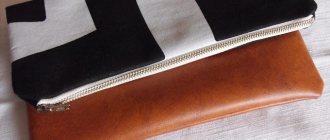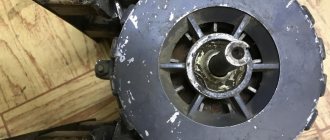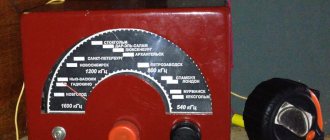I need a cheap and powerful subwoofer for my speakers, and instead of spending money on it, I decided to build a homemade subwoofer from a regular speaker at home. I found a 10-inch Pioneer TS-W255C for only 800 rubles and will tell you how to make a subwoofer with your own hands.
What you will need:
- Old computer power supply (wattage depends on how big your subwoofer/amplifier is)
- Car amplifier (something that can be a bridge and has a built-in crossover)
- Subwoofer. There are quite a lot of choices here, but most car subwoofers are poorly made. Look for a heavy magnet in a fancy casing.
- Speakers
- 18mm fiberboard, depends on the size of your subwoofer
- Several thick wires for speakers
Designing a subwoofer enclosure
Before you start purchasing materials and start working on how to make a subwoofer with your own hands, you need to design and roughly estimate the design and shape of the main part of the subwoofer - the housing.
The design of the case is divided into two main stages, each of which should be done as thoroughly and carefully as possible in order to ultimately obtain a high-quality product:
- Establishment and approval of Thiel-Small parameters for the loudspeaker
- Program for calculating acoustic designs
Other tools, such as a subwoofer box, can also be made by yourself.
All of the above can be purchased at almost every electronic goods store. Everything is installed according to the instructions that come with all components. Everything is written quite clearly and even a layman can figure it out and install everything without errors or breakdowns.
The main thing is to follow all the rules and do it carefully and carefully in order to make a high-quality subwoofer for the home with your own hands.
Manufacturing
Make a box for the subwoofer
Let's get started:
- The first step is to determine the size and shape of the future box. It will be useful to find a suitable housing drawing;
What to make a subwoofer box from
- We determine the material from which we will assemble the box. As mentioned above, marine plywood is considered the best material. If we couldn’t find it, then we use MDF or multilayer plywood.
Note. When choosing plywood, the main thing is to pay attention to its thickness. Try to select thick plywood, because the rigidity of the entire structure will depend on this, which will ultimately affect the sound. Thus, the optimal thickness for a subwoofer box is considered to be 18 mm. This is quite reasonable: you won’t have to spend a lot of money (the thicker the plywood, the more expensive it is) and the quality will remain at the same level. On the other hand, everyone decides for themselves and sometimes the weight of a homemade box can reach more than 50 kilograms.
- You don't have to cut plywood in your own garage. You can do this right in the store if you ask the seller to observe the appropriate dimensions. In many stores, cutting is completely free;
- We prepare the necessary materials: glue, preferably PVA, brushes, self-tapping screws or furniture screws, liquid nails and much more.
Note. Don’t forget to buy a piece of carpet, which we will use to cover the box at the last stage of production.
We are building a building
First of all, we start making the body of the box. Started:
- It is advisable to make the front part of the box, where the head will be fixed, double. We just put two sheets of plywood here and that's it. If the thickness of the plywood sheet is chosen to be 18 mm, then in this part the thickness should be all 36 mm, which will provide greater rigidity. This is very important, because it is this part of the box that receives the greatest impact.
Note. You can do it differently. A hole of normal size is made in the first sheet, and a larger hole is made in the second sheet, which is on the outside. Thus, the subwoofer head will be recessed into the body, which has a positive effect not only on technical capabilities, but also on aesthetic components.
Let's continue:
- We glue the plywood sheets together and then secure them with self-tapping screws. It is important not to skip screws, but to attach them to every 1 cm2 of wall area.
Note. In other words, it is advisable to tighten the screws every 3-5 cm.
- We connect the walls of the box body not with self-tapping screws, but with special furniture screws. To do this, we arm ourselves with a drill and drill holes for the screws. Then we drip glue into the hole we made and tighten the screw. Unlike self-tapping screws, screws will provide better fixation.
Note. Over time, furniture screws do not become loose, even from constant shaking and vibrations.
- A triangular strip is glued into the inner corners of the box if it is necessary to increase the rigidity of the structure. You can even install stretchers inside, which will prevent deformation of the body. It is recommended to do this only for large speakers (see How to choose speakers for a car radio on your own) with prohibitive power, since for medium and small ones this installation does not make sense.
Making computer calculations
Quite an important part of installing your own subwoofer. You should not rely one hundred percent on the devices and tools that you purchased. To be completely sure and confident that your home theater is working properly, you need to make preliminary computer calculations.
Computer programs do not provide for non-trivial solutions and errors that are typical for humans. This eliminates almost all risks and the possibility of error.
JBL subwoofers often use a computer plugin called JBL SpeakerShop. A fairly high-quality program that has wide functionality and runs smoothly even on the weakest computers and laptops.
Periodically, it is worth installing such software and checking the operation and functioning of all components of speakers and subwoofers.
What is a subwoofer?
Subwoofer is derived from two words - SUB and WOOFER, which is the literal translation of “subwoofer” and means an acoustic system capable of reproducing sounds at low frequencies, for example from 20 to 100 Hz. Many users prefer to call it a “bass speaker”.
Subwoofers are divided into two types:
- Active subwoofer - the speaker housing contains an amplifier and power supply.
- Passive subwoofer - it does not have an external amplifier.
Speaker
The speaker, in fact, is one of the simplest components of a subwoofer. But this goes against the fact that the speaker is the most important part of the entire mechanism.
Speakers are divided into several sections according to different parameters. Firstly, it is worth highlighting the separation of speakers by frequency. Specifically, the subwoofers you need use low-frequency speakers.
Low-frequency speakers with a frequency below 150 Hz are regularly used and are built into almost all subwoofers that can be used to equip a home theater.
Note!
- Do-it-yourself charger for a car battery: a step-by-step guide for making the device at home, selecting materials for assembling the structure
- DIY laboratory power supply | Step-by-step instructions on how and from what elements to build a power supply
- DIY antenna for digital TV - photo instructions on how to make simple antennas for digital TV
The speakers are not sold separately, but with special tools that, after installation, create a special acoustic design. This allows you to create high-quality and clear sound that will be pleasant to listen to and will delight you when watching movies or TV series at home.
Speakers aren't just used in home theaters. Also, similar equipment is purchased when setting up music and recording studios, and installed in cars for playing music loudly.
The types of acoustic design may be different, but you still shouldn’t purchase expensive professional equipment. This is done so that if you make a mistake, you won’t feel sorry for a lot of lost funds.
Seek help from specialists and special technical services. Yes, you have to spend a little money, but it’s worth it, because in the end you will get a high-quality subwoofer that will complement your home theater and work properly for a long time.
Selecting speakers for a subwoofer
Speakers compatible with the case can be used: 18Sound 18LW2400, B&C 18TBX100, RCF 18X401 or their parametric equivalents. In general, it is not at all difficult to choose a suitable speaker for this case. The vast majority of decent 18" will play well here, except for the cheap no-names and those with Qts above 0.4.
The subwoofer weighs about 45 kg. That's why there are handles on the sides: it's convenient for carrying. The center of gravity is shifted 265 mm from the rear edge.
Subwoofer design
It will not be possible to describe everything in as much detail as possible, and even in such a way that everyone can understand it. Not everyone understands such complex technology at the same level.
Note!
DIY induction heater - instructions on how to make a simple and powerful heater- Do-it-yourself sound amplifier: selection of materials and tools for making at home + step-by-step instructions for creating and assembling yourself
- Do-it-yourself wind generator: step-by-step instructions for making a device at home, choosing materials and type of construction
In order to understand in more detail and understand the entire design of the speakers, sound cards, and various accessories included in the subwoofer, you should find special technological maps and diagrams on the Internet. This can be done on any thematic forum or resource, or simply on a random site on the Internet.
Such images describe in detail the structure and design of such equipment. There are symbols, arrows and explanations of all abbreviations.
In general, everything is done to make it as clear and accessible as possible for you to study this issue. It is better to take ready-made drawings and diagrams for a subwoofer than to do it yourself.
How to make a housing for a subwoofer with your own hands
If you need to make a good box for a subwoofer, then it is best to focus on the most complex design. This system is called a bandpass. It comes in fourth order and sixth order. The fourth-order system is a two-chamber box, where one chamber is a closed box, and the other plays the role of a bass reflex.
A sixth-order bandpass is a design with two bass reflexes. The most difficult thing here is the calculation of the second port and the relative relationship of the settings of each bass reflex. The two chambers have different sizes and are capable of limiting the frequencies reproduced by the loudspeaker. The box for two subwoofers is the most difficult to design, but it has the maximum efficiency. To determine all sizes of such sound systems, special utilities are used. The universal WinISD program is suitable for calculating any subwoofer design. It does not have a Russian-language interface, but it is not difficult to understand. To make a drawing of a box for a subwoofer, just load the parameters of the speaker you are using into your computer.
Shield
In addition to the standard subwoofer device, it can be made in the form of an acoustic screen. To carry out this procedure, you will need a special tool called a shield.
But there is a catch - you can do this with your own hands at home only if the cladding of your walls is quite stable and made of high-quality materials.
Note!
Do-it-yourself incubator: a step-by-step master class on how to build it yourself, choosing building materials and type of constructionDo-it-yourself cyclone: methods for assembling the device at home, preparing materials and tools + step-by-step instructions
- DIY Bluetooth speaker - step-by-step master class on making and installing it yourself, necessary materials and tools
Otherwise, due to the high bass content, problems may arise with this and you will have to spend money on repairs. Do-it-yourself shield or sub is very risky, but if you do everything correctly, the final result will definitely surprise you.
How to make a housing for a subwoofer
The easiest to make is a buried box or box. This is a completely closed structure, the manufacture of which will require a minimum of simple wooden parts. How to make a housing for a sub becomes clear when you see such a device. Essentially, this is a rectangular box with a hole cut out in the front wall for a dynamic head. The box consists of six walls, which are easy to cut out of the appropriate material. A terminal block is mounted on the side or rear wall to connect wires from the amplifier. The closed box (CB) is distinguished by dense and not vague bass, smooth amplitude-frequency response, but has the lowest efficiency among all designs.
The box can be in the shape of a parallelepiped or trapezoid with beveled walls. Due to its characteristics, the closed design is suitable for many musical styles. The sealed, closed design conveys bass well in pop and rock music, classical, jazz and instrumental works. But fans of rap and dubstep will be disappointed, as the closed box is not suitable for playing music that has a lot of heavy bass and where the low frequencies are the basis of the music.
Antiacoustics
This is a very important part when arranging a home theater and a subwoofer in particular. You need to create excellent anti-acoustics, especially if you do not live in your own house, but in an apartment building.
Neighbors may complain about the loud noise, and they have a right. Create high-quality sound isolation and watch TV shows and movies, listen to music as much as you want.
The first thing you need to stock up on to create proper sound insulation is special acoustic foam. This is a fairly popular material that musicians regularly use to decorate their home music studios.
It is characterized by high efficiency and low cost. You can find soundproofing foam on various Internet resources from third-party manufacturers, then the price will be even lower.
You can also upgrade the existing walls in your home so that they add anti-acoustics and sound insulation. There is a special ceiling shape design that cannot be installed at home, but if you spend money and order the design from professionals, you definitely won’t regret it.
How to choose the right subwoofer?
First, let's define the tasks. As a rule, they come in two types: to sound special effects as part of a home theater or to play music.
In a cinema system, the main task of a subwoofer is to create the required sound pressure when dubbing special effects. Typically, subwoofers in a bass reflex housing are used for this. The reason for this is greater output in the lower range due to the fact that the bass reflex releases those low-frequency waves that are generated by the inside of the subwoofer speaker.
In addition, this design allows you to achieve fairly “big” bass from a relatively small speaker - and in a small housing. But bass reflex subwoofers also have disadvantages: they are more selective in choosing a place in your room. They also have a more uneven frequency response, because the resonance frequency of the subwoofer speaker and the bass reflex itself are different.
As a result, if you do not pay due attention to setting up and finding the most suitable place, you will end up with the same hum and muttering about which legends are made. Attempts to combine such a subwoofer into a triphonic with a stereo pair rarely end successfully. Bass reflex bass is characterized by power and depth, but not by any means the elasticity and quality of bass that high-record fans strive for.
A subwoofer in a closed box is the complete opposite. It is capable of fast, elastic and lean bass. It is less demanding on your room, loyal to music, has a smoother frequency response - all this is a plus. But in order to achieve powerful and deep bass from a closed subwoofer, which will be comparable in efficiency to a bass reflex one, we will need a much larger volume of the closed enclosure, and therefore more space in the room for the sub. Despite this, a closed box is much better suited for building a triphonic and other musical systems.
The purpose of such a subwoofer as part of a triphonic is to expand the frequency range of the speaker system. For a cinema system, a closed subwoofer will also be relevant, but with comparable parameters its size will be larger than that of its counterpart with a bass reflex.
Car subwoofers
As already partially mentioned earlier, subwoofers are used not only for home theaters and music studios. Some drivers who lack music and drive install powerful speakers, speakers and subwoofers in their car in order to listen to music loudly.
If you are one of these people, then you should remember that you can only play loud music during daylight hours, so as not to disturb the people around you. You need to remember not only about yourself.
Amplifier installation
Now we need to try to make an active subwoofer.
To prepare the amplifier, the algorithm of actions is as follows:
- Creating a printed circuit board using a trace map. According to the drawing, radio elements are laid out and soldered at the ends to the road board.
- The wire is soldered in to provide electrical power at the output and input.
- Using screw racks, the radiator is installed inside the box.
When the power of the speakers is up to 100 watts, it is necessary to supplement the amplification stages. The quantity may vary, depending on how much space remains inside the subwoofer.
In this case, a stronger cooling system will be required, supplying air jets to each transistor. The radiator helps remove unnecessary heat from the power elements.
Installing a car subwoofer
Do-it-yourself subwoofers are placed in the car mainly in the cargo compartment. There is another, less popular option, when this device is attached directly to the driver’s seat. Both positions provide excellent audibility, acoustics and sound quality that will allow you to listen to music in the car without any problems.
Of course, making your own under-seat subwoofers will look better than its counterpart.
The advantage of installing a subwoofer in your car is that it does not require certain additional accessories. You won't even need to remove any components of your car dealership.
There are different types of subwoofers in cars. The most popular are the stealth type. They are distinguished by clear sound, regardless of bass content. So, they are quite organic, as the name suggests.
Installing stealth car subwoofers will not cause you any problems or breakdowns. It is enough just to choose a copy that is suitable in shape and size and secure it tightly in the car using special fasteners.
A DIY subwoofer for your car is simple and very effective.
Auto subwoofer
Are you interested in a car subwoofer? Then keep in mind that the choice of location for their implementation is not limited to the trunk or directly next to the driver's seat.
Let's talk about trunk space. There is one caveat: this arrangement takes up quite a bit of free storage space. But if you take into account the location under the driver’s seat, there is a significant risk of damaging the subwoofer with your feet.
It is also worth focusing on one very significant point, namely: you cannot do without the mandatory effect of masking noise in a cramped car interior.
Due to this factor alone, almost every car subwoofer is primarily optimized for bass.
The subwoofer opens the curtain on a whole dimension of the musical world for us! I think you have noticed before how different the sound can be.
For example, remember the thin, weak, melodic sounds from home acoustics. Do you remember? Now, for contrast, imagine the same composition, only if it is played in a concert stadium, where powerful bass rumbles from large speakers, making you feel it in your body!
A good subwoofer setting adds depth to the music being played and emphasizes the beauty of the low frequencies. In this situation, low waves will not dominate, and the person listening to the composition will be immersed in the overall picture.
Filters
Yes, installing filters is not a necessary procedure if you are going to use the subwoofer in a country house, where no one will hear and you will not disturb anyone. In addition, filters prevent certain sound defects caused by excessive bass or too loud sound effects.
Subwoofer filters are a fairly affordable and inexpensive accessory that almost everyone can afford. Similar items are sold in a special themed music equipment store.
If there is no such store in your city, then try to find music filters in an electrical and computer instrument store.
Filters are necessary for the proper functioning of a homemade subwoofer.
How to make a subwoofer box correctly
Before you start making a subwoofer box, you need to choose a loudspeaker. The volume of the future structure will depend on its parameters. Most often, specialized imported loudspeakers with a diameter of 10-12 inches are used to reproduce powerful bass. Structurally, the subwoofer box can be made in three options:
- Closed box
- Bass reflex
- Bandpass
The quality of the loudspeaker and the design of the box ultimately determine the sound quality of the low-frequency sound system.
Photos of do-it-yourself subwoofers
Subwoofer circuit diagrams
The scheme as a whole and further the same, but in separate blocks (for convenience).
Preamp + filter
Front panel potentiometer
LED level indicator
Dynamics protection
Amplifier
Next, the electronics are assembled. First, we will screw the power transformer and run the wires to the power source.
The PSU board is basically an 8A bridge rectifier that rectifies up to 42V DC balanced. There are 2 capacitors of 1000 uF per channel. Next, the LM317/337+2x4700uF assembly, which produces symmetrical 12V. Next to the LM317 and LM7805 with the same capacitors for +12V power for the rest of the boards and the front panel USB header.
Below is a photo of the signal processing board:
The board includes 2 preamplifiers, a fourth-order low-pass filter with a cutoff frequency of 70 Hz and damping of 24 dB/octave, a phase shifter with a range from 0 to -180 degrees. and phase inversion 180 degrees. There is a UPC1237 protection board according to the original schematic.
And this is the installation of the speaker in the subwoofer housing:











